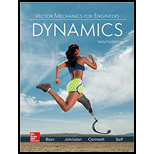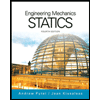
VECTOR MECH...,DYNAMICS(LOOSE)-W/ACCESS
12th Edition
ISBN: 9781260265521
Author: BEER
Publisher: MCG
expand_more
expand_more
format_list_bulleted
Concept explainers
Question
Chapter B, Problem B.7P
To determine
(a)
The mass moment of inertia of the platewith respect to
To determine
(b)
The mass moment of inertia of the plate about
Expert Solution & Answer
Want to see the full answer?
Check out a sample textbook solution
Students have asked these similar questions
This is a tilt and rotation question. Here are notes attached for reference.
Thermodynamics: Mass and Energy Analysis Of Control Volumes
A spring-loaded piston-cylinder device contains 1.5 kg of carbon dioxide. This system is heated from 200kPa and 25◦C to 1200 kPa and 300◦C. Determine the total heat transfer to and work produced by this system.
Can you help with a code in MATLAB?
Chapter B Solutions
VECTOR MECH...,DYNAMICS(LOOSE)-W/ACCESS
Ch. B - A thin plate with a mass m is cut in the shape of...Ch. B - Prob. B.2PCh. B - Prob. B.3PCh. B - Prob. B.4PCh. B - A piece of thin, uniform sheet metal is cut to...Ch. B - Prob. B.6PCh. B - Prob. B.7PCh. B - Prob. B.8PCh. B - Prob. B.9PCh. B - Prob. B.10P
Ch. B - Prob. B.11PCh. B - Prob. B.12PCh. B - Determine by direct integration the mass moment of...Ch. B - Prob. B.14PCh. B - A thin, rectangular plate with a mass m is welded...Ch. B - A thin steel wire is bent into the shape shown....Ch. B - Prob. B.17PCh. B - Prob. B.18PCh. B - Prob. B.19PCh. B - Prob. B.20PCh. B - Prob. B.21PCh. B - Prob. B.22PCh. B - Prob. B.23PCh. B - Prob. B.24PCh. B - Prob. B.25PCh. B - Prob. B.26PCh. B - Prob. B.27PCh. B - Prob. B.28PCh. B - Prob. B.29PCh. B - Prob. B.30PCh. B - Prob. B.31PCh. B - Determine the mass moments of inertia and the...Ch. B - Prob. B.33PCh. B - Prob. B.34PCh. B - Prob. B.35PCh. B - Prob. B.36PCh. B - Prob. B.37PCh. B - Prob. B.38PCh. B - Prob. B.39PCh. B - Prob. B.40PCh. B - Prob. B.41PCh. B - Prob. B.42PCh. B - Prob. B.43PCh. B - Prob. B.44PCh. B - A section of sheet steel 2 mm thick is cut and...Ch. B - Prob. B.46PCh. B - Prob. B.47PCh. B - Prob. B.48PCh. B - Prob. B.49PCh. B - Prob. B.50PCh. B - Prob. B.51PCh. B - Prob. B.52PCh. B - Prob. B.53PCh. B - Prob. B.54PCh. B - Prob. B.55PCh. B - Determine the mass moment ofinertia of the steel...Ch. B - Prob. B.57PCh. B - Prob. B.58PCh. B - Determine the mass moment of inertia of the...Ch. B - Prob. B.60PCh. B - Prob. B.61PCh. B - Prob. B.62PCh. B - Prob. B.63PCh. B - Prob. B.64PCh. B - Prob. B.65PCh. B - Prob. B.66PCh. B - Prob. B.67PCh. B - Prob. B.68PCh. B - Prob. B.69PCh. B - Prob. B.70PCh. B - For the component described in the problem...Ch. B - Prob. B.72PCh. B - For the component described in the problem...Ch. B - Prob. B.74P
Knowledge Booster
Learn more about
Need a deep-dive on the concept behind this application? Look no further. Learn more about this topic, mechanical-engineering and related others by exploring similar questions and additional content below.Similar questions
- I need help writing a code in MATLAB. Please help me with question b.6arrow_forwardThermodynamics: Mass and Energy Analysis Of Control Volumes 1.5-kg of water that is initially at 90◦C with a quality of 5 percent occupies a spring-loaded piston-cylinder device. This device is now heated until the pressure rises to 900 kPa and the temperature is 280◦C. Determinethe total work produced during this process, in kJ.arrow_forwardThermodynamics: Mass and Energy Analysis Of Control Volumes Stainless steel ball bearings (ρ = 8085 kg/m3 and cp = 0.480 kJ/(kg◦C)) having a diameter of 1.5 cm areto be quenched in water at a rate of 900 per minute. The balls leave the oven at a uniform temperature of1000◦C and are exposed to air at 25◦C for a while before they are dropped into the water. If the temperatureof the balls drops to 900◦C prior to quenching, determine the rate of heat transfer from the balls to the air.arrow_forward
- Thermodynamics: Mass and Energy Analysis Of Control Volumes A 12-ft3 tank contains oxygen at 15 psia and 80◦F. A paddle wheel within the tank is rotated until thepressure inside rises to 20 psia. During the process 25 Btu of heat is lost to the surroundings. Determine thepaddle wheel work done. Neglect the energy stored in the paddle wheel.arrow_forwardThermodynamics: Mass and Energy Analysis Of Control Volumes A frictionless piston-cylinder device contains 4.5 kg of nitrogen at 110 kPa and 200 K. Nitrogen is nowcompressed slowly according to the relation PV1.5 = constant until it reaches a final temperature of 360 K.Calculate the work input during the process, in kJ.arrow_forwardThermodynamics: Mass and Energy Analysis Of Control Volumes An insulated piston-cylinder device contains 4 L of saturated liquid water at a constant pressure of 200 kPa.Water is stirred by a paddle wheel while a current of 8 A flows for 50 min through a resistor placed in thewater. If one-half of the liquid is evaporated during this constant-pressure process and the paddle-wheelwork amounts to 300 kJ, determine the voltage of the source. Also, show the process on a P–v diagram withrespect to the saturation lines.arrow_forward
- Thermodynamics: Mass and Energy Analysis Of Control Volumes The state of liquid water is changed from 55 psia and 45◦F to 2000 psia and 120◦F. Determine the change inthe internal energy and enthalpy of water on the basis of the (a) compressed liquid tables, (b) incompressiblesubstance approximation and property tables, and (c) specific-heat model.arrow_forwardThermodynamics: Mass and Energy Analysis Of Control Volumes What is the change in enthalpy, in kJ/kg, of oxygen as its temperature changes from 150 to 250◦C? Is thereany difference if the temperature change were from −50 to 100◦C? Does the pressure at the beginning andend of this process have any effect on the enthalpy change?arrow_forwardThermodynamics: Mass and Energy Analysis Of Control Volumes A 50-L electrical radiator containing heating oil is placed in a 50-m3 room. Both the room and the oil in theradiator are initially at 5◦C. The radiator with a rating of 3 kW is now turned on. At the same time, heatis lost from the room at an average rate of 0.3 kJ/s. After some time, the average temperature is measuredto be 20◦C for the air in the room, and 60◦C for the oil in the radiator. Taking the density and the specificheat of the oil to be 950 kg/m3 and 2.2 kJ/(kg◦C), respectively, determine how long the heater is kept on.Assume the room is well-sealed so that there are no air leaks.arrow_forward
- Problem 3 For the beam and loading shown, consider section n-n and determine (a) the largest shearing stress in that section, (b) the shearing stress at point a. 1ft 15 kips 20 kips 15 kips AITT in 1 0.6 in. -10 in. 1 in. 0.375 in.- 2 ft 2ft 2 ft 2ft 10 in. 1 0.6 in.arrow_forwardpractice problems want detailed break downarrow_forward6.105. Determine force P on the cable if the spring is compressed 0.025 m when the mechanism is in the position shown. The spring has a stiffness of k = 6 kN/m. E P 150 mm D T 30° 200 mm 200 mm 200 mm B 800 mmarrow_forward
arrow_back_ios
SEE MORE QUESTIONS
arrow_forward_ios
Recommended textbooks for you
 International Edition---engineering Mechanics: St...Mechanical EngineeringISBN:9781305501607Author:Andrew Pytel And Jaan KiusalaasPublisher:CENGAGE L
International Edition---engineering Mechanics: St...Mechanical EngineeringISBN:9781305501607Author:Andrew Pytel And Jaan KiusalaasPublisher:CENGAGE L

International Edition---engineering Mechanics: St...
Mechanical Engineering
ISBN:9781305501607
Author:Andrew Pytel And Jaan Kiusalaas
Publisher:CENGAGE L
moment of inertia; Author: NCERT OFFICIAL;https://www.youtube.com/watch?v=A4KhJYrt4-s;License: Standard YouTube License, CC-BY